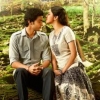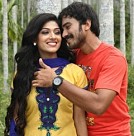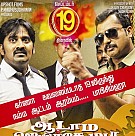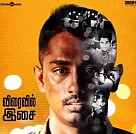“VIJAY, SURIYA AND VIKRAM ARE AS DISCIPLINED AS THE ACTORS IN THE WEST” – PADMA SHRI SANTOSH SIVAN (PART 1)
Interview Team : Sudharshan Padma Shri Santosh Sivan is not just a leading cinematographer by profession, he also breaths, eats, lives and thinks art. If we say, bend it like Beckham and live like Santosh Sivan, you wouldn’t argue with us. In his busy life, he makes sure he finds time to have some fun. “What’s the use of working so hard, if we don’t deserve some fun in life?” – Smiles Santosh Sivan. He visits the Amazon when he is bored and doesn’t stick to one kind of project. Mix it up is his mantra.
No wonder he has an impeccably sharp eye for great locations. He resides in a very peaceful villa, well surrounded by lush greens amidst a bustling industrial area in the outskirts of Chennai.
The veteran finds time to chat leisurely with our correspondent, Sudharshan Giridhar about his projects, perspectives and strategies. Excerpts…
PHOTOS & STILLS - GALLERY
You have introduced a new visual technology in Anjaan (Red Dragon Digital)…
Yes, I have. But, do you want to hear the truth? All these new technologies don’t really work out here. In this digital era, quality has nothing to do with the kind of camera.
Red Dragon Digital with 6 K resolution, which we have used in Anjaan, is truly awesome, no questions about it. But at the end of the day, we use multiple cameras for shooting, ranging from Red Dragons to Go Pros, which are the most inexpensive equipments, to 5Ds and 7Ds.
So, when the footages finally go through an exhaustive phase of post-production, every footage must be matched. That also involves bringing down the quality of the sequences shot by the Red Dragon. And most importantly, when it comes to our theaters, the projection will be in 2K resolution.
So the reason behind exploiting these high end equipments is to keep ourselves on par with the international standards.
All these new technologies don’t really work out here.
When you cannot use a high end equipment to its fullest capacity (or throughout the movie), why use it?
Cameras are like cars. If the roads are smooth and less congested, we might take Mercs or other high-end cars. To navigate faster through the heavy city traffic, we prefer smaller cars. Sometimes, scooters or even a bicycle would prove much more useful.
Similarly, the kinds of cameras we use depend on various factors like locations, permissions, budget, etc…
How good is it to have actors like Suriya and Vijay on the sets? How much difference do they make during the production process?
I have worked on a lot of projects. But, only a handful projects with big stars. What I admire in actors like Suriya, Vijay and Vikram, is their commitment. They come to the sets before everyone else, get ready for their shoot and perform with utmost sincerity and passion.
Another quality that these three share is that they keep to themselves. They make sure they don’t waste any time and they’ll appreciate if their time isn’t wasted.
I also find them as disciplined as the actors in the west.
Suriya, Vijay and Vikram make sure they don’t waste any time and they’ll appreciate if their time isn’t wasted
India currently has some extraordinary actors and you have worked with most of them. What does it take to become a superstar?
Most of them have identities of their own and they have a way of doing things differently. Most importantly, they have radiance of sorts that draws people’s attention.
If you ask me what makes them standout as incredible performers, it is their ability to react. There’s acting and there’s reacting. Take actors like Mohanlal for example, they are like goal keepers. In which ever direction the ball travels, they jump instinctively towards it.
Take actors like Mohanlal for example, they are like goal keepers
Say you pick up a project. After a couple of schedules, you realize that there is no freshness in the film. Do you give the director a heads up or do you not interfere in his business?
There are a number of reasons I look into before taking up a film. If I like the directors or their previous works, I sign. If the film has scope for me to explore a new space, I take it.
Varieties are also very important. If the film has something I have never done before, I will bend towards it. I don’t like to get bored. The variety is what keeps me going. Sometimes, I pick a film just for the sake of finding out what can it possibly offer me.
But once I take up a project, no matter how brilliant or bad it is, I try to stick to it.
Once I take up a project, no matter how brilliant or bad it is, I try to stick to it
You seem to be very choosy about your projects…
I’m not choosy. I just don’t take up too many projects, as I do a lot of other things too. I like making documentaries and small films. Hence, I don’t generally take up projects that go on for a long time. I mix it up – I do a film, then a documentary and then a small movie.
At the same time, I don’t want to be a workaholic. I like to have a little fun, to keep me from getting bored.
Secondly, I like to work with directors. I don’t want to sound too brash, but I don’t like it when actors recommend me. I don’t prefer being picked for a project based on the word of actors.
I don’t like it when actors recommend me
How do you remain the best?
(Laughs) When someone graduates out of a film school, it is normal to feel as if he/she is the best thing that is going to happen to the film industry. I think that kind of belief is very good.
When I graduated I felt the same way. I didn’t want to work as an assistant to anyone. I believed I had learnt all from my Dad, Mr Sivan.
When I realized I wasn’t being offered any Job, I moved to Arunachal Pradesh to teach. That’s when I learnt my biggest and the most valuable lesson – that the travel is the best teacher. From the land of backwaters, I moved to the home of Himalayas, in search of a living.
I found their culture very different. Apart from being pink, the people there are very muscular and they all carry swords, even students. In fact, there’s a statue of Gandhi, as muscular as them and with a huge stick. I just couldn’t make them understand Gandhiji was nonviolent.
I fell in love with what I saw there, the perspectives, the innocence and that kick started my desire to travel more. Even today, I travel a lot during my free time. The Amazon is my favourite spot and I think it is these travels that keep my thoughts fresh.
Mystery makes life enjoyable and likewise cinematography must have the right share of shadows along with the light.
I didn’t want to work as an assistant to anyone. I believed I had learnt all from my Dad, Mr Sivan.
Your most difficult project till date…
No film is easy. But, how you handle the difficulties is what matters. I will have to say Iruvar was the most difficult movie I have done. The film required the visuals to be very raw and authentic. It also demanded a lot of mise-en-scene, which aren’t easy to compose. Iruvar needed me to stick to the grammar of cinematography. Mani wanted old-school framing, but with current technologies.
Sometimes, cinematography is like a 5-day test match. Only if you know the game well you’ll be able to enjoy it thoroughly.
In the second part, we talk in detail about Mani Ratnam, the Inam controversy, his stalker, life after Padmashri and more.
Iruvar was the most difficult movie I have done
FACEBOOK COMMENTS
OTHER LATEST INTERVIEWS
CINEMATOGRAPHER SANTOSH SIVAN RELATED NEWS
- Yarumilla about to take the radio waves by storm
- “Please don’t condemn Anjaan”
- The much anticipated opening weekend numbers of Suriya's Anjaan
- After Mankatha, Venkat Prabhu is again astonished by Masss
- Suriya zooms ahead of Superstar Rajini and the rest
- Samantha joins the select bikini brigade
- Anjaan bangs to the top !
- Anjaan, with twists and turns
- Suriya, Vidyut and Yuvan leave for….
- “I want to prove a point”, says Samantha
- Anjaan does it within just 3 days
- Anjaan - Housefull !
- A Dhanush – Ilayaraja treat before Anjaan
- Team Anjaan brings about a revolution in South India
- Anjaan gets bigger and bigger with every passing day !
CINEMATOGRAPHER SANTOSH SIVAN RELATED LINKS
- What Samantha has to say about her heroes ? Especially Siddharth !
- Anjaan- Visitor Review
- Anjaan - Visitor Review
- Anjaan- Movie Review by Common Man
- Anjaan Movie Review
- "I'm doing a very hot and sexy guest appearance in Anjaan"
- Director Lingusamy - "I have no explanations for why I like Anushka" - BW
- Samantha - "If you have inhibitions, you should not become an actress"
- Why is Anjaan big even before its release ?
- "The highlight of Anjaan is its screenplay" - Brinda Sarathy
- Anjaan - Ek Do Teen Song
- Anjaan Movie Preview
- Anjaan Team Meet
- Anjaan Trailer
- "My relationship with Ajith is very special", Vidyut Jammwal










